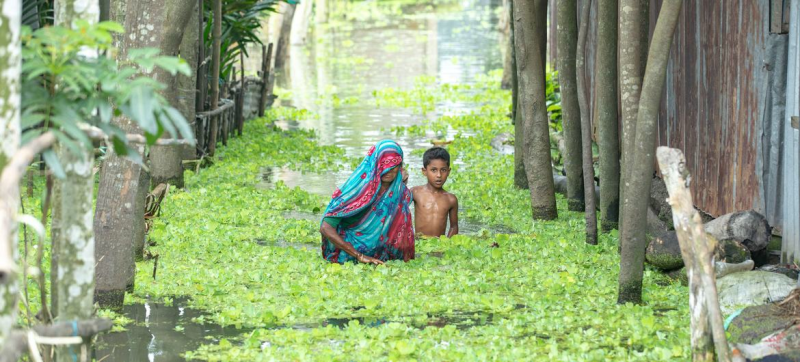- Climate Change Drives Deadly Floods, Storms, and Water Crises |
- UN Advances Peace, Development Amid Global Challenges |
- S Arabia, Pak ink defence pact after Israeli strike on Qatar |
- No new committee forming, focus on polls candidates: Tarique |
- Dhaka-Beijing partnership to advance peace, prosperity: Yunus |
Climate Change Drives Deadly Floods, Storms, and Water Crises

A woman and child wads through floodwater in Kurigram, Bangladesh .
The world’s water resources face growing pressure from climate change, while emergencies involving this life-giving resource increasingly impact lives and livelihoods, the UN World Meteorological Organization (WMO) said on Thursday.
“Water-related hazards continue to cause major devastation this year,” said Celeste Saulo, WMO Secretary-General. “The latest examples are the devastating monsoon flooding in Pakistan, floods in South Sudan, and the deadly flash floods on the Indonesian island of Bali. Unfortunately, we see no end to this trend.”
Ms. Saulo noted that these emergencies have been occurring amid increasingly warm air temperatures, which allow more water to be held in the atmosphere, leading to heavier rainfall.
Her comments coincided with the publication of a new WMO report on the state of the world’s waterways, snow, and ice. The report notes that 2024 was the hottest year in 175 years of observation, with the annual mean surface temperature reaching 1.55 °C above the pre-industrial baseline from 1850 to 1900.
In September 2024, central and eastern Europe experienced devastating flash floods caused by deadly Storm Boris, which uprooted tens of thousands of people. Similar disasters are likely to happen more often, even though they should—in theory—be extremely rare.
In the Czech Republic, several rivers flooded in an extreme fashion “that actually statistically should only occur every 100 years,” said Stefan Uhlenbrook, WMO Director of Hydrology, Water, and Cryosphere Division.
“A ‘century event’ happened…unfortunately, statistics show that these extreme events might become even more frequent.”
Another example of the increasingly erratic behaviour of the world’s water cycle is the extremely heavy rainfall that affected parts of Himachal Pradesh and Jammu & Kashmir.
“The region saw extremely heavy rainfall when it was not expected; the monsoon came early,” said Sulagna Mishra, WMO Scientific Officer. “The unpredictability of the system is growing more and more.”
Turning to the impact of last year’s pronounced El Niño phenomenon, the WMO report indicates it contributed to severe drought in the Amazon Basin. Northwest Mexico and northern North America saw below-average rainfall, as did southern and southeastern Africa.
“El Niño at the start of 2024 played a role,” explained Ms. Saulo, “but scientific evidence shows that our changing climate and rising temperatures lead to more extreme events, both droughts and floods.”
The WMO report also confirmed wetter-than-normal conditions over central-western Africa, Lake Victoria in Africa, Kazakhstan and southern Russia, central Europe, Pakistan and northern India, southern Iran, and northeastern China in 2024.
One key message of the UN agency report is that what happens to the water cycle in one part of the world has a direct impact elsewhere.
Melting glaciers continue to be a major concern because of the speed at which they are disappearing and the existential threat they pose to downstream and coastal communities.
“2024 was the third consecutive year with widespread glacial loss across all regions,” Ms. Saulo said. “Glaciers lost 450 gigatonnes, the equivalent of a huge ice block seven kilometres high, wide, and deep—or 180 million Olympic swimming pools—adding about 1.2 millimetres to global sea levels and increasing the risk of floods for hundreds of millions of people on the coasts.”
The report also highlights the urgent need for improved data-sharing on streamflow, groundwater, soil moisture, and water quality, which remain heavily under-monitored.

